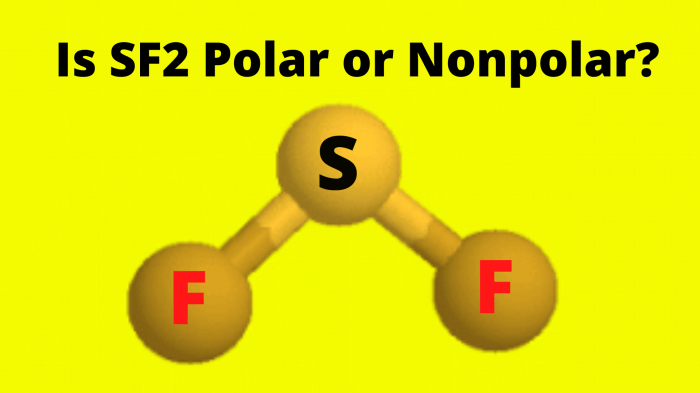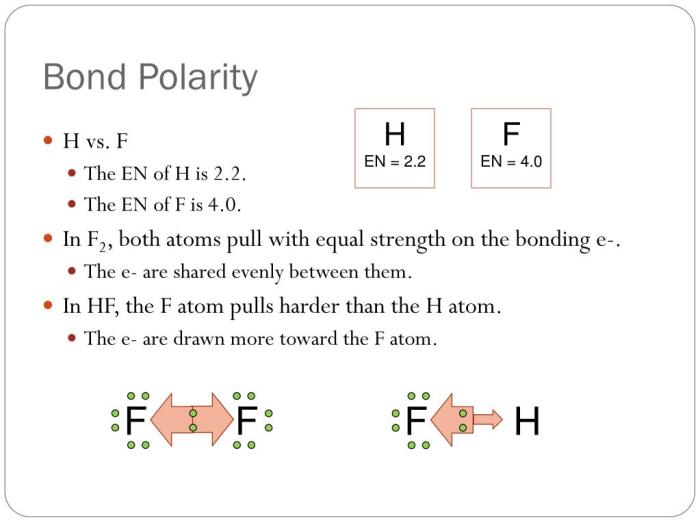Embarking on a scientific expedition, we delve into the intriguing realm of molecular polarity. At the heart of our inquiry lies a compelling question: is IF2 polar or nonpolar? Join us as we navigate the intricacies of molecular structure, electronegativity, and experimental evidence to unravel the polarity of this enigmatic molecule.
The concept of polarity, a fundamental aspect of chemistry, plays a pivotal role in shaping the behavior and properties of molecules. Understanding the polarity of IF2 opens doors to comprehending its chemical reactivity, intermolecular interactions, and applications in various scientific fields.
Definition of Polarity

Polarity is a fundamental concept in chemistry that describes the distribution of electrical charge within a molecule or chemical bond. It is determined by the electronegativity of the atoms involved, which refers to their ability to attract electrons towards themselves.
Polarity can be classified into three main types:
Polar Covalent Bonds, Is if2 polar or nonpolar
Polar covalent bonds occur when the electronegativity difference between two atoms is small to moderate (0.4-1.7). In these bonds, the electrons are not shared equally, resulting in a partial positive charge on one atom and a partial negative charge on the other.
This creates a dipole moment, which is a measure of the polarity of the bond.
The question of whether IF2 is polar or nonpolar is still up for debate. In the meantime, why not take a break and try to unscramble “w o l v e s”? The answer might surprise you! w o l v e s unscramble Once you’ve solved that puzzle, come back and let’s continue our discussion on IF2’s polarity.
Nonpolar Covalent Bonds
Nonpolar covalent bonds occur when the electronegativity difference between two atoms is very small (less than 0.4). In these bonds, the electrons are shared equally, resulting in no net charge on either atom. This creates a nonpolar molecule.
Ionic Bonds
Ionic bonds occur when the electronegativity difference between two atoms is large (greater than 1.7). In these bonds, one atom completely transfers an electron to the other, resulting in the formation of positively and negatively charged ions. This creates a strong electrostatic attraction between the ions, forming an ionic compound.
Molecular Structure and Polarity
Molecular structure plays a pivotal role in determining the polarity of a molecule. Polarity refers to the uneven distribution of electrons within a molecule, resulting in a separation of positive and negative charges.
Electronegativity, a measure of an atom’s ability to attract electrons, influences the polarity of a molecule. When atoms with different electronegativities bond, the more electronegative atom attracts electrons towards itself, creating a partial negative charge. The less electronegative atom, in turn, acquires a partial positive charge.
Polar Molecules
In polar molecules, the partial positive and negative charges are separated by a significant distance, resulting in a permanent dipole moment. Examples include water (H 2O) and ammonia (NH 3), where the electronegative oxygen and nitrogen atoms attract electrons, creating partial negative charges, while the hydrogen atoms have partial positive charges.
Nonpolar Molecules
Nonpolar molecules, on the other hand, have a symmetrical distribution of electrons, resulting in no net dipole moment. Examples include methane (CH 4) and carbon dioxide (CO 2), where the electronegativities of the atoms involved are similar, and the electrons are evenly distributed.
IF2 Molecular Structure

IF2, or iodine difluoride, has a molecular structure that significantly influences its polarity. To determine the polarity of IF2, we need to delve into its molecular structure and electronegativity differences.
Electronegativity Difference
Electronegativity is a measure of an atom’s ability to attract electrons towards itself in a chemical bond. The electronegativity difference between iodine and fluorine is crucial in understanding IF2’s polarity. Iodine has an electronegativity of 2.66, while fluorine has an electronegativity of 3.98. This significant difference in electronegativity indicates that fluorine has a stronger pull on the shared electrons in the IF2 molecule.
Polarity Prediction
Based on the electronegativity difference, we can predict the polarity of the IF2 molecule. Since fluorine has a higher electronegativity than iodine, the electrons in the IF2 bond will be pulled towards the fluorine atoms. This uneven distribution of electrons creates a polar covalent bond, where the fluorine atoms have a partial negative charge (δ-) and the iodine atom has a partial positive charge (δ+).
Experimental Evidence of Polarity: Is If2 Polar Or Nonpolar

Determining molecular polarity experimentally involves measuring the distribution of electric charge within the molecule. One method for assessing polarity is through dipole moment measurements.
Dipole Moment Measurements
Dipole moment is a vector quantity that describes the separation of positive and negative charges within a molecule. A nonpolar molecule has a zero dipole moment, while a polar molecule has a non-zero dipole moment.
Dipole moment measurements can be obtained using various techniques, including:
- Microwave spectroscopy: Measures the absorption of microwave radiation by molecules, which is affected by the dipole moment.
- Dielectric constant measurements: Determines the ability of a material to store electrical energy, which is influenced by the polarity of its molecules.
- Electrostatic deflection experiments: Uses an electric field to deflect molecules, with the extent of deflection depending on the dipole moment.
Applications of Polarity

Polarity is a crucial concept in chemistry that significantly influences various chemical processes and physical properties. It plays a vital role in determining the behavior of molecules and their interactions with each other.
One of the most important applications of polarity lies in its influence on intermolecular forces. Polar molecules exhibit dipole-dipole interactions, which are attractive forces between the positive and negative ends of the molecules. These interactions are stronger than the van der Waals forces that exist between nonpolar molecules, leading to higher boiling points and melting points for polar compounds.
Hydrogen Bonding
A special type of dipole-dipole interaction is hydrogen bonding, which occurs when a hydrogen atom is bonded to a highly electronegative atom such as oxygen, nitrogen, or fluorine. Hydrogen bonding is a very strong intermolecular force that can have a profound effect on the physical properties of substances.
For example, water is a liquid at room temperature due to the strong hydrogen bonding between its molecules.
Solubility
Polarity also affects the solubility of compounds. Polar compounds tend to dissolve in polar solvents, while nonpolar compounds tend to dissolve in nonpolar solvents. This is because polar solvents can form dipole-dipole interactions or hydrogen bonds with the solute molecules, whereas nonpolar solvents cannot.
Boiling Point
The boiling point of a liquid is the temperature at which its vapor pressure equals the surrounding atmospheric pressure. Polar liquids have higher boiling points than nonpolar liquids of similar molecular weight because of the stronger intermolecular forces between the polar molecules.
Q&A
What is molecular polarity?
Molecular polarity arises when a molecule possesses an uneven distribution of electrical charge, resulting in a separation of positive and negative charges within the molecule.
How does electronegativity influence molecular polarity?
Electronegativity, a measure of an atom’s ability to attract electrons, plays a crucial role in determining molecular polarity. A greater difference in electronegativity between bonded atoms leads to a more polar molecule.
What experimental methods can be used to determine molecular polarity?
Dipole moment measurements, a technique that gauges the separation of positive and negative charges within a molecule, provide valuable insights into molecular polarity.